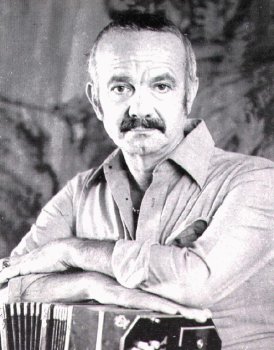| B i o g r a p h y |
 Ástor Pantaleón Piazzolla
(March 11, 1921 – July 4, 1992) was an Argentine tango composer
and bandoneón player. His oeuvre revolutionized the traditional
tango into a new style termed nuevo tango, incorporating elements from
jazz and classical music. He is therefore widely considered the most
important tango composer of the latter half of the twentieth century. A
formidable bandoneonist, he regularly performed his own compositions
with different ensembles. He is known in his native land as "El Gran
Ástor" ("The Great Astor").
Ástor Pantaleón Piazzolla
(March 11, 1921 – July 4, 1992) was an Argentine tango composer
and bandoneón player. His oeuvre revolutionized the traditional
tango into a new style termed nuevo tango, incorporating elements from
jazz and classical music. He is therefore widely considered the most
important tango composer of the latter half of the twentieth century. A
formidable bandoneonist, he regularly performed his own compositions
with different ensembles. He is known in his native land as "El Gran
Ástor" ("The Great Astor").
Piazzolla was born in Mar del Plata, Argentina in 1921 to Italian parents, Vicente Piazzolla and Asunta Manetti. His grandfather, a sailor and fisherman named Pantaleón Piazzolla, had emigrated to Mar del Plata from Trani, a seaport town in the southeastern Italian region of Apulia, at the end of the 19th century. Ástor Piazzolla spent most of his childhood with his family in New York City, where he was exposed to both jazz and the music of J.S. Bach at an early age. While there, he acquired fluency in four languages: Spanish, English, French, and Italian. He began to play the bandoneon after his father, nostalgic for his homeland, spotted one in a New York pawn shop. At the age of 13, he met Carlos Gardel, another great figure of tango, who invited the young prodigy to join him on his current tour. Much to his dismay, Piazzolla's father deemed that he was too young to go along. Nevertheless he played a young paper boy in Gardel´s movie El dia que me quieras. This early disappointment proved a blessing in disguise, as it was on this tour that Gardel and his entire band perished in a plane crash. In later years, Piazzolla made light of this near miss, joking that had his father not been so careful, he wouldn't be playing the bandoneon — he'd be playing the harp.
He returned to Argentina in 1937, where strictly traditional tango still reigned, and played in night clubs with a series of groups including the orchestra of Anibal Troilo, then considered the top bandoneon player and bandleader in Buenos Aires. The pianist Arthur Rubinstein — then living in Buenos Aires — advised him to study with the Argentine composer Alberto Ginastera. Delving into scores of Stravinsky, Bartók, Ravel, and others, he rose early each morning to hear the Teatro Colón orchestra rehearse while continuing a gruelling performing schedule in the tango clubs at night. In 1950 he composed the soundtrack to the film Bólidos de acero.
At Ginastera's urging, in 1953 Piazzolla entered his Buenos Aires Symphony in a composition contest, and won a grant from the French government to study in Paris with the legendary French composition teacher Nadia Boulanger. The insightful Boulanger turned his life around in a day, as Piazzolla related in his own words:
Piazzolla returned from New York to Argentina in 1955, formed the
Octeto Buenos Aires to play tangos, and never looked back. Upon
introducing his new approach to the tango (nuevo tango), he became a
controversial figure among Argentines both musically and politically.
The Argentine saying "in Argentina everything may change — except
the tango" suggests some of the resistance he found in his native land.
However, his music gained acceptance in Europe and North America, and
his reworking of the tango was embraced by some liberal segments of
Argentine society, who were pushing for political changes in parallel
to his musical revolution. During the period of Argentine military
dictatorship from 1976 to 1983, Piazzolla lived in Italy, but returned
many times to Argentina, recorded there, and on at least one occasion
had lunch with the dictator Jorge Rafael Videla. However, his
relationship with the dictator might have been less than friendly, as
recounted in Astor Piazzolla, A manera de Memorias (a comprehensive
collection of interviews, constituting a memoir):
What an invitation! They sent a couple of guys in black suits and a letter with my name on it that said that Videla expected me a particular day in a particular place. I have a book around in some place, with pictures of all the guests: Eladia Blázquez, Daniel Tinayre, Olga Ferri, the composer Juan Carlos Tauriello, there were painters, actors [...]
In 1990 he suffered thrombosis in Paris, and died two years later in Buenos Aires.
Among his followers, his own protege Marcelo Nisinman is the best
known innovator of the tango music of the new millennium, while Pablo
Ziegler, pianist with Piazzolla's second quintet, has assumed the role
of principal custodian of nuevo tango, extending the jazz influence in
the style. The Brazilian guitarist Sergio Assad has also experimented
with folk-derived, complex virtuoso compositions that show Piazzolla's
structural influence while steering clear of tango sounds; and Osvaldo
Golijov has acknowledged Piazzolla as perhaps the greatest influence on
his globally oriented, eclectic compositions for classical and klezmer
performers.